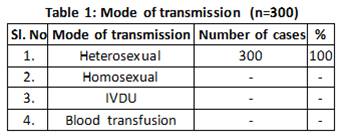Abstract
74% of HIV seropositive individuals from study group belonged to low socio economic status and 26% belonged to middle socioeconomic status. Occupational status among 100 HIV seropositive individuals studied, 45.58% (31/68) of males and 53.12% (17/32) of females were laborers. 23.52% (16/68) of males were drivers. 5.88% (4/68) of males were businessmen. 11.76% (8/68) of males were farmers. 8.82% (6/68) of males and 3.12% (1/32) of females were employees.4.41% (3/68) of males were unemployed. 43.75% (14/32) of females were housewives. Isosporaoocyst was the predominant parasite detected in stool samples 28 (40%), followed by cryptosporidium 15(21%) Strongyloides larvae 12 (17%) and Ascaris ova 11 (17%) each, E. histolytica cyst & Giardia trophozoites.
Full text article
Generated from XML file
Authors
Gundala obulesu, Hunumanthappa A.R, & Prabakar reddy E. (2023). Prevalence of opportunistic infection of intestinal parasitic and bacteria HIV-1 /AIDS positive individuals & comparative withCD4 cell counts in kadapa. International Journal of Research in Pharmaceutical Sciences, 8(2), 176–181. Retrieved from https://ijrps.com/home/article/view/4556
Copyright (c) 2017 International Journal of Research in Pharmaceutical Sciences

This work is licensed under a Creative Commons Attribution-NonCommercial-NoDerivatives 4.0 International License.

